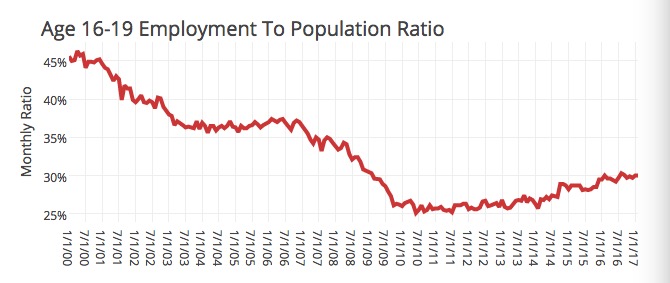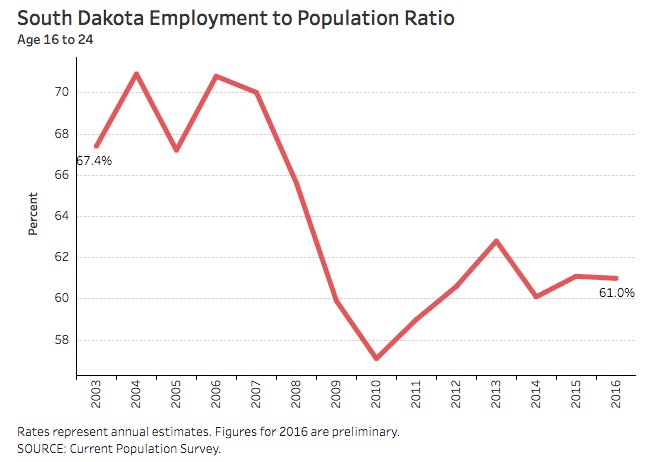Hey! David Novstrup! Did you read your Governing update this morning?
I opened my copy and thought I’d found one little shred of data that might, against most other economic indicators, suggest that David Novstrup’s youth minimum wage (you know, the really bad idea we voters overwhelmingly rejected last year) might have been a reasonable idea. Mike Maciag crunches new data on youth employment and finds South Dakota has seen the share of young people age 16 to 24 holding down jobs has dropped 8.3 percentage points, from a 69.3% average from 2005 to 2007 (the highest in the nation at that time) to 61.0% in 2016 (seventh highest in the nation).
Oh my—did raising the minimum wage in 2015 kick young people out of the workforce, just as Novstrup and his Republican colleagues argued it would?
Nope. South Dakota’s youth employment downturn reflects a larger national trend in which the last two recessions provoked notable declines—around ten percentage points each—in the share of 16- to 19-year-olds nationwide holding jobs. After 2001, that share did not bounce back; After 2009, it crept back slowly, regaining not quite half of its loss:

Why aren’t as many kids working? It’s more likely their priorities, not minimum wage pressures:
One possible explanation, says Ross, is that teenagers have gradually become more focused on academics and extracurricular activities than earning a paycheck. Additionally, reforms led to high schools offering fewer career and technical education courses in favor of a greater emphasis on college prep [Mike Maciag, “The Uneven Recovery of Youth Employment,” Governing, 2017.04.05].
Now take a look at the trajectory of the youth employment decline in South Dakota:

The recession actually dropped South Dakota more than eleven points from its nation-topping pre-recession youth employment share. From 2010 to 2013, youth employment share climbed back around six points, then dropped three points in 2014, the year before we increased the minimum wage from $7.25 to $8.50. When that wage hike kicked in in 2015, the share of young South Dakotans working increased, just a little. When we added the a nickel in 2016, youth employment share crept down a tiny bit.
So once again, economic data show no clear negative impact of a higher minimum wage on youth employment. Sorry, David!
https://1.bp.blogspot.com/-f6U8SmdXLjU/WOVt5tCMlzI/AAAAAAABmQc/Jh0yypWiMg8a_o3vgkeg_blbEjSz5QcTQCLcB/s640/reaganomics.jpg